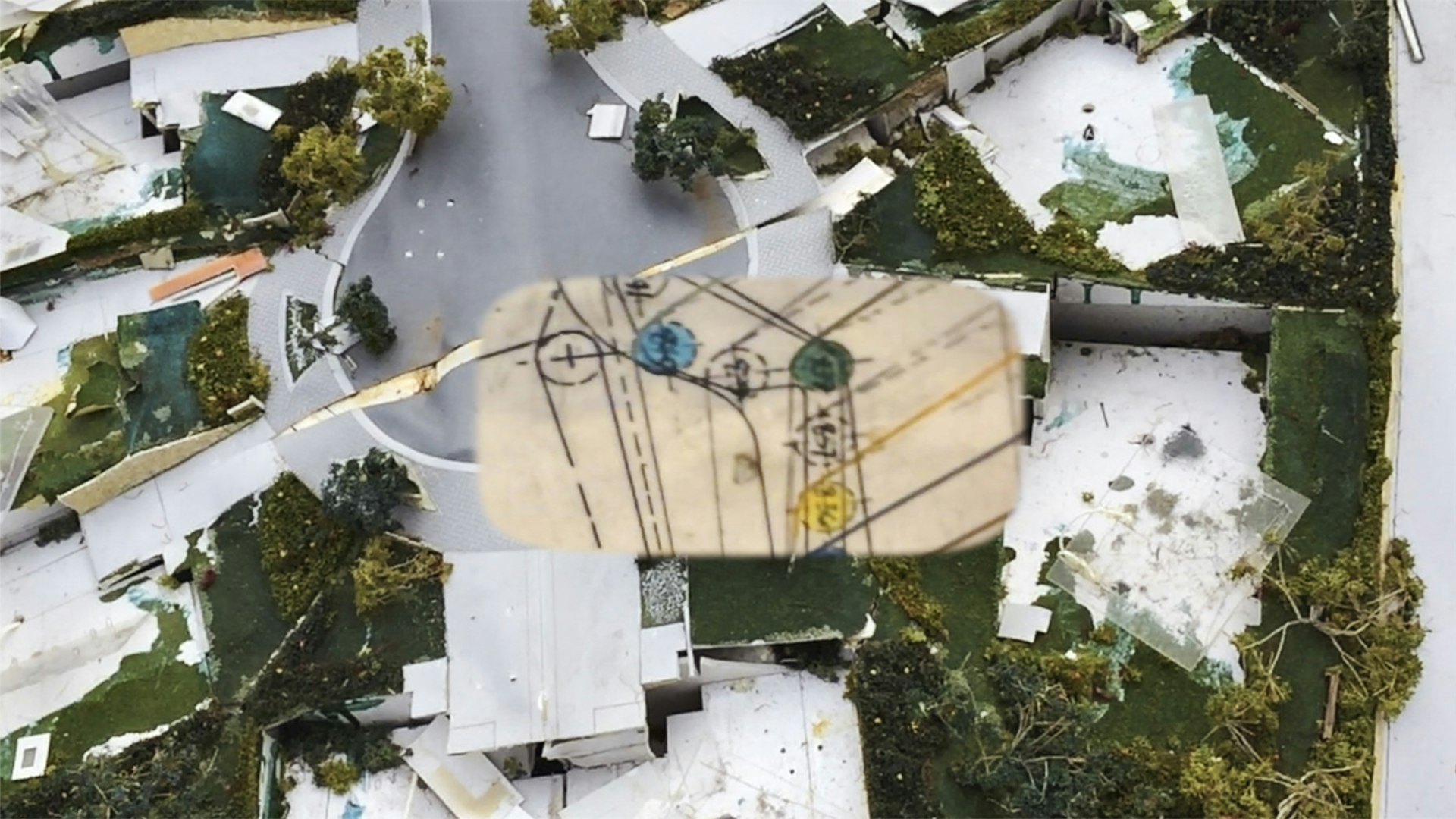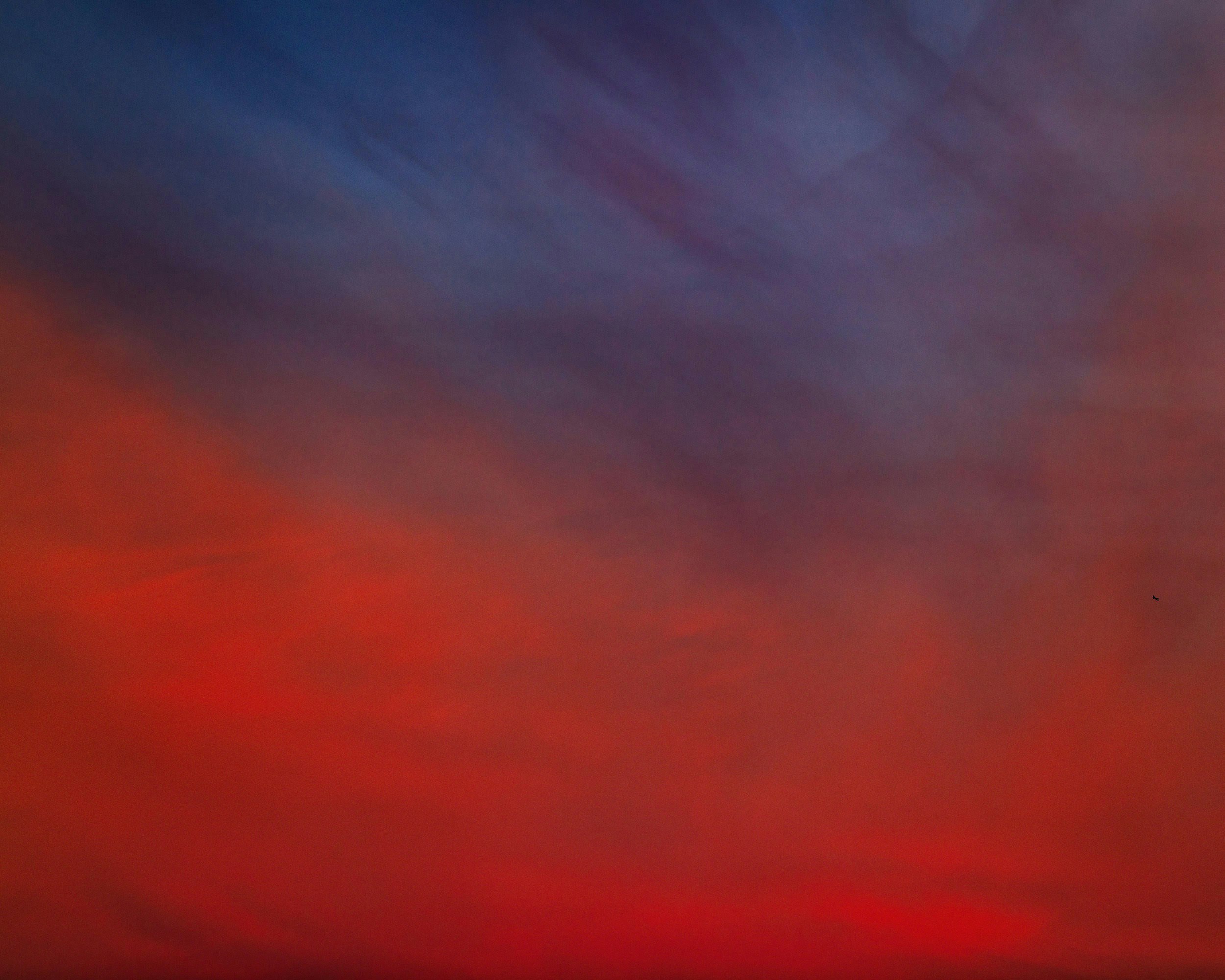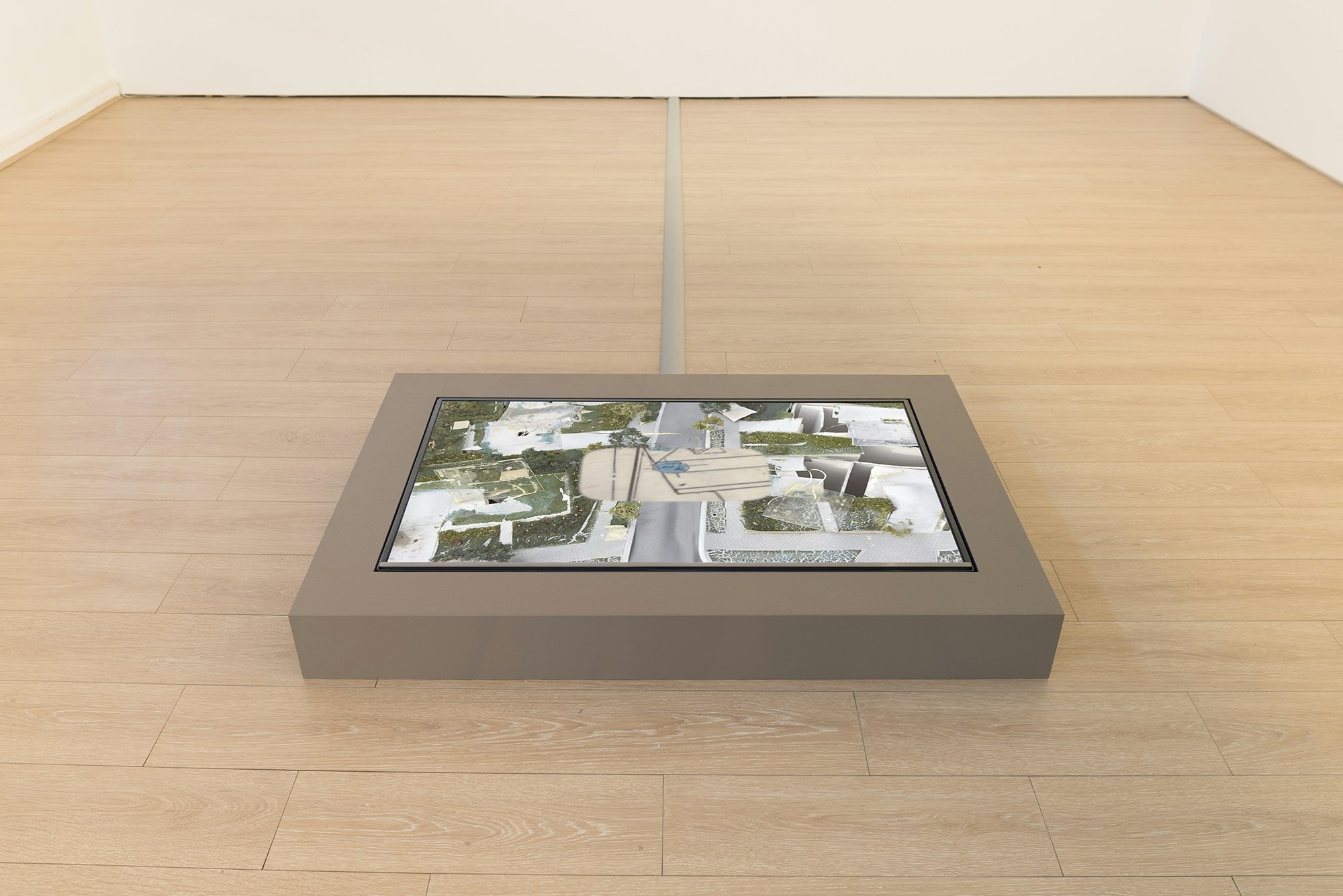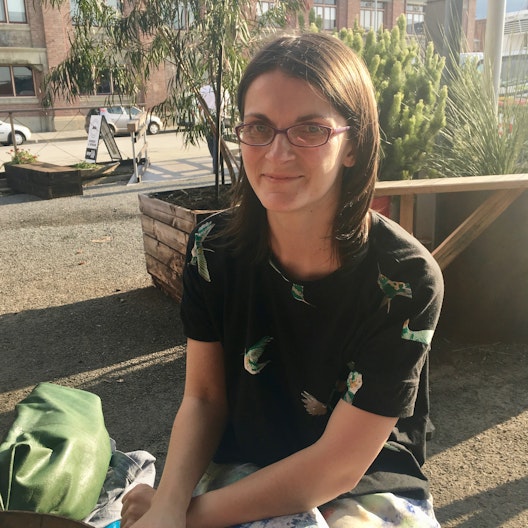A non-site implication: Sonia Leber and David Chesworth’s Earthwork
Kate Warren

Sonia Leber and David Chesworth, Earthwork (video still), 2016, HD video, 5 minutes; courtesy the artists.
Earthwork (2016) by Sonia Leber and David Chesworth is disorientating in multiple ways. A single-channel video, it is installed on the gallery floor, so that viewers must look downwards to see the images on-screen. If this action of peering down from on high is not dizzying enough, the video’s imagery, framings and soundtrack all amplify the head-spinning experience. Earthwork’s camera is in constant movement, barely pausing as it scans a damaged and ruined landscape. Houses and trees lie destroyed and streets deserted; an ‘aftermath’ scene that is recognisable, but not specifically locatable in terms of geography or topography. Superimposed in the middle is a second frame, much more abstract and difficult to decipher. Using similarly mobile but tightly cropped camerawork, it scans some sort of map or technical plan, panning across obscure symbols, coordinates and visual data. As viewers try to reconcile the relationship between these two frames, an ominous aural drone rises all the while, becoming louder and louder until it eventually cuts out without warning, and the cycle re-starts.
Leber and Chesworth’s video mimics the viewpoint of an unmanned aerial drone. These weapons of contemporary warfare have been described by Edwin Jacob as the ‘quintessential weapon in America’s “war on terror”’ (1). The deadly ‘appeal’ of drones is that they keep soldiers out of direct harm’s way. Another contemporary artist working with these ideas and responding to this technology, Jerusalem-born and Berlin-based Omer Fast, describes drones as paradoxical ‘objects of desire and wish fulfilment’ (2), because they displace the reality of conflict and offer illusions of warfare as clinical, precise and removed. The United States’ drone program is driven by secretive, opaque and hidden systems of data and control. Drones exert control over physical sites through secretive non-sites and virtual representations, yet they have very real effects and deadly consequences. In 4A Centre for Contemporary Asian Art’s exhibition I don’t want to be there when it happens, co-curated by myself and 4A Director Mikala Tai, we are given a sense of these ongoing traumatic effects through works by artists Adeela Suleman and Raj Kumar. While neither of these Pakistani artists speaks exclusively to the harm caused by drone warfare, they consider the complex interplays between violence, religion and global geo-politics. Their works are driven from and informed by their direct experiences as Pakistani citizens, living under real threat of conflict.
By contrast, Australian artists Sonia Leber and David Chesworth are removed from the immediate and life-threatening realities of conflict in Pakistan, or other regions targeted by contemporary warfare. Earthwork displaces these present-day realities into a speculative scenario, performing a role-reversal and re-orientation that is forceful in its simplicity. The destroyed landscape is in fact a discarded and damaged architectural model that the artists found at a rubbish tip. As the camera sweeps from above, the tell-tale signs of Australian suburbia appear across the frame—quarter-acre blocks, cul-de-sac streets, nature strips planted with trees—though the camerawork is decidedly not choreographed. The artists framed their searching shots ‘blind’, so-to-speak, by simply moving the camera over the model without looking through the viewfinder. The camera’s gaze does not stop at the model’s defined edges. This miniaturised world, so realistic and detailed, almost seems to levitate above the detritus of the tip below.
This introduces another frame into Earthwork’s visual plane, further complicating and multiplying any clear sense of place or site. Being detached and removed as they and their machinic gaze are, Leber and Chesworth in effect assume the position of quasi-drone operators, which is why Earthwork’s inclusion in the exhibition was deemed necessary. Through this position, they implicate themselves, the exhibition viewers and by extension the broader general public in the destruction wrought by contemporary conflict. This type of speculative ‘role-reversal’ scenario is immediately confronting because it creates a scene that is highly recognisable, but re-imagined through a lens of destruction and trauma that is vastly unfamiliar to many (if not most) people living in Australia and other Western societies (3). It is an uncanny scenario: not only because the destroyed houses connect directly to the original German term, unheimlich (unhomely), but also because it projects a return of a repressed socio-political responsibility for actions taken ‘at a distance’. Installing the screen on the floor is a simple but important decision, forcing viewers to physically assume the same viewpoint of the drone/camera operator, further implicating them in this speculative scenario.
This type of speculative ‘role-reversal’ scenario is immediately confronting because it creates a scene that is highly recognisable, but re-imagined through a lens of destruction and trauma that is vastly unfamiliar to many (if not most) people living in Australia and other Western societies.
In his 2015 book simply titled Drone, Adam Rothstein argues that contemporary discourses around drones—be they philosophical, commercial, political or militaristic discourses—are profoundly speculative, because there is ‘nearly no limit of possible uses for [drones]’ (4). In this context, speculation can also serve as a means to ‘ignore the ill effects we are perpetuating today’ (5)—the point at which artists often step in. An increasing number of contemporary artists have begun to engage with and critique the use of weaponised drones. They regularly deploy speculative and fictionalised scenarios, often critical and dystopic in character, to confront the viewers and make visible the power structures that sustain these militarised programs (6). As film theorist Felicity Colman argues of the contemporary turn to speculation, such practices ‘are productive of methodologies that are not creative of new technologies but creative of systems for thinking technology’ (7).
Through its fictionalised scenario and physical installation, Earthwork engages in an immediate implication of the viewer. In a more understated way though, Leber and Chesworth draw on another very particular artistic legacy, highlighting a broader understanding of Western socio-political incrimination in contemporary conflicts. The title of the video is a direct reference to American artist Robert Smithson and his iconic ‘earthwork’ projects such as Spiral Jetty (Rozel Point, Great Salt Lake, Utah, 1970), as well as his conceptualisation of the ‘site’ and ‘non-site’ dialectic (8). Spiral Jetty is one of the most impressive realisations of Smithson’s idea of the ‘site’ as ‘physical, raw reality’ (9). As Smithson writes, it was the specificities and physicality of the site that generated the final form of this now famous work: ‘From that gyrating space emerged the possibility of the Spiral Jetty’ (10). In contrast to the ‘open limits’ and ‘scattered information’ of the site, Smithson conceived of his ‘non-sites’ as abstract representations of real sites, with defined boundaries and contained information (11). The non-site doesn’t just represent the site, it confines, distils and centralises it (12). Smithson’s non-sites take various forms, including topographic maps and scale models (e.g. A Nonsite, Pine Barrens, New Jersey, 1967) and multi-media installations (e.g. Gravel Mirrors with Cracks and Dust, 1968), which displace and materially reconfigure distant sites. As Colman observes, ‘Smithson’s mirror-displacements are but precursors of the metals of mobile technology communication devices’ (13).
Yet in the context of contemporary data and communicative systems, Smithson’s concept of the non-site is also transformed. These shifting relations are recognised by Trevor Paglen, who has been one of the earliest and most consistent artists of his generation to document, visualise, expose and critique the United States’ programs of drone warfare and data surveillance. His practice of clandestinely photographing restricted and classified military bases and their activities regularly takes him to some of America’s most remote locations (14). In a recent lecture on Smithson at Dia:Chelsea, Paglen showed an image of a ‘USGS quad map’, a key example of the institutional and imperial system of topographical grids that ‘imposed order on the desert, but […] at the cost of reducing the desert to a mathematical construction’ (15). The particular map that Paglen chose was important two-fold: firstly, because it was the USGS quad map of Rozel Point, where Spiral Jetty is located; and secondly because the map is in fact blank—it does not actually depict the landscape.

Trevor Paglen, Untitled (Reaper Drone), 2010, C-print, 48 x 60 inches (121.9 x 152.5 cm); courtesy the artist and Metro Pictures, New York (MP# TP–1).
Paglen observes that it is ‘useful to have a non-place, a blank spot on the map. […] Blank spots on the map are usually never blank, but there is something under there that someone doesn’t want you to see’ (16). These maps obscure as much as they reveal. The quad map is perhaps the perfect dialectical non-site to Smithson’s quintessential ‘site’, the blank grid as the antithesis to the dynamic spiral. In photographs of Spiral Jetty, the large structure seems to spiral inwards from the peninsula of Rozel Point into the expanse of the Great Salt Lake. Spiral Jetty is geographically remote but it is far from isolated—as such, it also spirals outwards. It sits in a landscape that few people experience directly, but which has profoundly affected people geographically far-removed. This broader geographic region was also the site of US nuclear tests in the 1950s, and other classified military locations (the infamous town of Roswell is not far away). Today, less than 800 kilometres south-west of Spiral Jetty is the Creech Air Force Base in Nevada, from where the US military launches and controls its fleet of drones, and which Paglen describes as an ‘outer spiral’ of Smithson’s earthwork (17). These spiralling connections remain alive and active today, implicating governments, systems, and individual citizens in their effects, hence the military–industrial complex’s need to maintain its secretive non-sites at all costs.
With all this in mind, perhaps the important contemporary dialectic is not so much between site and non-site, but rather between non-site as representation/displacement (as for Smithson), and non-site as concealment/erasure (in contemporary military–surveillance culture). Smithson anticipated this when he said that ‘all the points […] obliterate once again the expansiveness of the sites, so that the points of the nonsite envelop the entire site’ (18). However, the artist may not have foreseen the extent to which the sites are being concealed. Paglen, for instance, describes the effects of the increasingly long Californian wildfire season (exacerbated by climate change), which produces haze that travels longer, further, and in fact obscures the view of military sites that he photographs. Many of the photographs that he has taken would be impossible today, due to this ‘permanent haze’ (19).
These sifting relations also inform Leber and Chesworth’s contemporary mediation, particularly in the connections between the video’s various frames. While Earthwork is informed by Smithson’s dialectic between site and non-site, neither of the work’s moving images—the scale model, and the frame of co-ordinates—really depict ‘sites’. A key interplay emerges, between two non-sites which both displace any ‘real’ site in favour of inferred and illusory locations. Furthermore, the relationship between these two images remains perpetually unclear. Do they actually correspond? Do these coordinates map the area below? Resembling the shape of a smartphone, the superimposed image visualises some kind of hidden data, but in its smaller size it is impossible for the viewer to decipher. Even the work’s physical installation alludes to other potential non-sites. Placed in the middle of the gallery space, the thin covering that conceals the monitor’s cables seems to become a conduit to another portal, perhaps to a hidden, classified site (20).

Sonia Leber and David Chesworth, Earthwork (installation view), 2016, HD video, 5 minutes; 4A Centre for Contemporary Asian Art, I don't want to be there when it happens, 2017, photo: Document Photography, courtesy the artists.
The word ‘drone’ also has specific aural meanings: ‘a continuous low humming sound’, or ‘a continuous musical note of low pitch’. Sound is an essential element of Leber and Chesworth’s practice more broadly, and in Earthwork the soundtrack rises from an almost imperceptible hum to a loud drone of stretched notes and chords (21). It infiltrates the entire gallery; then, without warning, this dense sound sharply cuts off, leaving an unexpected void demanding to be filled. Installed as it was in 4A’s upstairs gallery, most visitors would hear the work before seeing it. It conditions them to expect something imminent and ominous, continuing the vital framework of implication that I don’t want to be there when it happens sought to engage.
In countries like Australia, citizens are largely sheltered from direct harm of contemporary conflict, much like drone pilots. The level and nature of our implication in the destruction caused is far from clear and straightforward; while we may not pull any triggers, we are nonetheless conditioned by a world which, as Joanna Bourke argues, has been infiltrated by war (22). Through its striking and speculative visual and aural construction, Earthwork adds an important element of recognition, such that we as viewers cannot comfortably and mentally remain ‘at arm’s length’.
Notes
(1) Edwin Jacob, ‘Killing at a Distance’, in Homeland and Philosophy: For Your Minds Only, ed. Robert Alp (Chicago: Open Court, 2014).
(2) Omer Fast and Eyal Weizman, ‘Five Thousand Feet Is the Best: Omer Fast’, Photoworks 19 (2012): 63.
(3) Of course we must be alert to the problematic potentials for over-identification and appropriation. In this sense, I find Dominick LaCapra’s discussions about the productive use of empathy in representations of trauma useful, which ‘puts oneself in the other’s position while recognizing the difference of that position and hence not taking the other’s place’. Dominick LaCapra, Writing History, Writing Trauma (Baltimore: Johns Hopkins University Press, 2001), 78.
(4) Adam Rothstein, Drone (New York: Bloomsbury Academic, 2015), 43.
(5) Ibid., xi.
(6) An incomplete list of recent works by contemporary artists considering drones in relation to warfare and surveillance includes Louise Lawler’s No Drones (2011), Jananne al-Ani’s Shadow Sites II (2011), Omer Fast’s Five Thousand Feet is the Best (2011), Mahwish Chishty’s Drone Art Paintings (2011–), multiple works by British artist James Bridle from 2012 onwards, George Barber’s Freestone Drone (2013), Ryoichi Kurokawa’s Sirens (2013), Ruben Pater’s Drone Survival Guide (2013), Baden Pailthorpe’s MQ9 Reaper I (2014), Joseph DeLappe’s The Drone Project (2014), Joseph Delappe’s In Drones We Trust (2014), Laura Poitras’s Astro Noise (2016), and Kathryn Brimblecombe-Fox’s Dronescapes (2016–). Some significant exhibitions include Once Is Nothing: A Drone Art Exhibition (InterAccess, Toronto, 2016), Drone Art (Imperial War Museum, London, 2016), To See Without Being Seen: Contemporary Art and Drone Warfare (Mildred Lane Kemper Art Museum, St. Louis, 2016).
(7) Felicity Colman, ‘Speculative Data: Creativity and Roberth Smithson’ (lecture, H2HD2, 7 February 2015). Available online here (accessed 1 October 2017).
(8) I’m grateful to the artists for the various discussions had about the importance of Smithson as an influence. Chesworth in particular develops these ideas in fuller detail through his associated PhD project and exegesis.
(9) Robert Smithson, ‘Earth (1969)’, in Robert Smithson: The Collected Writings, ed. Jack Flam (Berkeley; Los Angeles: University of California Press, 1996), 178.
(10) Robert Smithson, ‘The Spiral Jetty (1972)’, in Robert Smithson: The Collected Writings, ed. Jack Flam (Berkeley; Los Angeles: University of California Press, 1996), 146.
(11) Ibid., 152.
(12) Jack Flam, ‘Introduction: Reading Robert Smithson’, in Robert Smithson: The Collected Writings, ed. Jack Flam (Berkeley; Los Angeles: University of California Press, 1996), xviii.
(13) Felicity Colman, ‘Speculative Geometry: Robert Smithson’s Glass Jars, Satellites and Material Aesthetics’, Journal of Visual Art Practice 15, no. 2–3 (2016): 232.
(14) Particularly in works such as the Untitled (Drone) (2010) and Limited Telephotography (2007–12) series.
(15) Trevor Paglen, ‘Trevor Paglen on Robert Smithson’ (lecture, Dia:Chelsea, New York, 25 October 2016). Available online here (accessed 1 October, 2017).
(16) Ibid.
(17) Ibid.
(18) Robert Smithson, ‘Four Conversations Between Dennis Wheeler and Robert Smithson / Edited by Eva Schmidt (1969–1970)’, in Robert Smithson: The Collected Writings, ed. Jack Flam (Berkeley; Los Angeles: University of California Press, 1996), 221.
(19) Paglen, 2016.
(20) Known in military terms as a known as a Sensitive Compartmented Information Facility, or SCIF.
(21) A number of contemporary artists, such as Lawrence Abu Hamden, and Jennifer Allora and Guillermo Calzadilla, critically explore the historical and ongoing uses and effects of sound and noise as a weapon. See also James Parker’s research at the University of Melbourne.
(22) Joanna Bourke, Wounding the World: How Military Violence and War-Play Invade Our Lives (London: Virago Press, 2015).
About the contributor
Kate Warren is an art historian, writer and curator from Melbourne. She was co-curator (with Mikala Tai) of 4A’s exhibition I don’t want to be there when it happens (2017).
